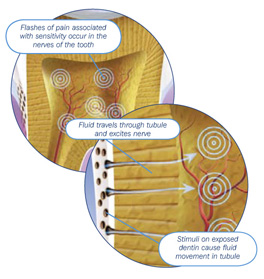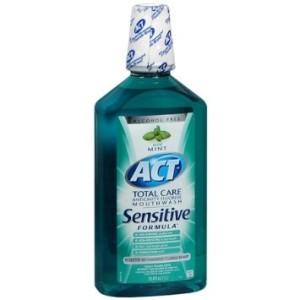Sensitive teeth are no JOKE!

- Dehydration: breathing in dry air
- Temperature change: eating ice cream or drinking hot coffee
- Chemical changes from diet: like eating acidic foods or sweet candy
If this sounds like what you have been experiencing, don’t fret! There is something that can be done. The simplest solution to repairing the exposed dentinal tubules is to cover them up. There are several ways you can go about this and most can be done right at home!
1. Using a “sensitive tooth” toothpaste. There is a component in the toothpaste called potassium nitrate that acts like a plug to the tubes opened to the outside. Plugging up the tubes will reduce or eliminate the movement of the liquid inside and thus decrease sensitivity and pain. However, this does not occur overnight. You will need to use the toothpaste over a period of time (up to 2 months) before you notice a significant reduction in sensitivity. Also, to continue results you must keep using sensitive tooth toothpaste.
and thus decrease sensitivity and pain. However, this does not occur overnight. You will need to use the toothpaste over a period of time (up to 2 months) before you notice a significant reduction in sensitivity. Also, to continue results you must keep using sensitive tooth toothpaste. 
2. Fluoride. The concentration of fluoride in tap water and toothpaste is too low to treat dentinal hypersensitivity, so more concentrated products could be used such as over-the-counter fluoride rinses, pastes, and gels. These function in a similar fashion to potassium nitrate and cork the dentinal tubules.
3. Fluoride varnishes. These can be placed on sensitive areas by your hygienist or dentist. Fluoride varnishes are a highly concentrated, sticky, fluoride matrix that adheres to the tooth and plugs up dentinal tubes. These are highly effective and can create sensitivity relief for up to 6 months.
4. Sealing the tooth surface with bonding agents. Bonding agents are a thin, clear glue typically used when fillings and crowns are placed, but it can also act as a seal on the surface of a sensitive tooth.

5. “Surgical solution”. If the chemical options do not work (as mentioned above) and relief cannot be found, then your dentist might recommend a gum graft. A gum graft is when the dentist covers up the exposed area with a piece of gum taken from another part of the mouth (usually the palate). This procedures covers up the tubes with what was suppose to be there in the first place, your gums!
The effects of these solutions can vary. In my experience dealing with patients complaining of sensitivity, I’ve found that the most effective solutions are first trying a sensitive tooth toothpaste and if that doesn’t provide relief then getting a fluoride varnish applied. If sensitivity is still unbearable, then I’ll discuss the possibility of a gum graft with the patient, however this option will probably not be as economically favored.
If you are looking for a dentist in the Triangle area, give DurhamDDS a call! We offer a generous helping of dental services for patients of all ages. To set up an appointment call our office at 919-286-0779 or visit our website at durhamdds.com for more information. You will be enjoying that ice cream cone in no time! Does this article have you craving for more? Please +1 us if you are a gmail-er or like us on Facebook. It is very easy to do, right at the top of the article! Thanks for reading!